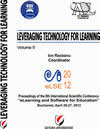INTEROPERABILITY STRATEGIES FOR SERIOUS GAMES DEVELOPMENT
INTEROPERABILITY STRATEGIES FOR SERIOUS GAMES DEVELOPMENT
Author(s): Ştefan Antoniu, Theo LIM, Ioana Andreea Stănescu, Milos Kravcik, Rafael BidarraSubject(s): Education
Published by: Carol I National Defence University Publishing House
Keywords: Serious games; interoperability; SCORM; LOM; LMS; SG-MIF
Summary/Abstract: Serious games have emerged as a new medium that enable players to acquire and enhance their skills and knowledge particularly in education and increasingly across a spectrum of fields from industrial and emergency training to marketing. While the use of serious games has extended rapidly to a variety of domains, their design and development remains a challenging process both for developers and teachers/trainers. This paper approaches the technological environment underpinning the development of serious games, and focuses on interoperability as a core element of a sustainable endeavour. Developing serious games in a way that enables interoperability is one means of increasing the depth and scope of instructional materials available to learners while reducing the overall development costs and time. Interoperability, the ability of computers and applications to communicate and share resources in a heterogeneous environment, is dependent on standards. Optimizing requirements of accessibility, interoperability, durability, and reusability for maximizing cost efficiency start with a proper understanding and integration of standards. The authors argue that interoperability provides a context for the development of sharable education resources and technologies which in turn allow for collaborative education in a field in which rapid technological developments are making it difficult for instructors and developers to stay up-to-date with both the science and the related technologies. The paper analyses various Serious Games interoperability scenarios and address the main gaps surrounding standardization in this field with the purpose of assisting developers and teachers in implementing successful solutions. The scenarios are based on a Serious Game Multidimensional Interoperability Framework that integrates three key dimensions: the core components included within a serious game (game mechanics, gameplay, graphics engine, graphic objects), the ecosystem where the serious game will be implemented (developing platforms, programming languages, LMS communications) and external factors that go beyond the core technical aspects of a serious game (assessment, applicability, classification, glossary of terms). The research considers the existing standards – such as SCORM and LOM - that impact serious games development, as well as gaps and fragmentation issues that hinder the development process with the purpose of identifying efficient, adaptable solutions.
Journal: Conference proceedings of »eLearning and Software for Education« (eLSE)
- Issue Year: 8/2012
- Issue No: 02
- Page Range: 373-378
- Page Count: 6
- Language: English

